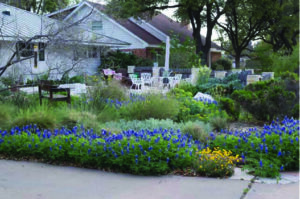By Debbie Roland and
Emmy Ulmschneider
Master Gardeners
Throughout our articles, we have stressed the importance of planting native plants in our yards and suggested alternatives to commonly grown, non-native plants. But two questions remain: Why does it matter? and Where can you get native plants?
The first question is perhaps the most easily answered. You plant natives because you get the most bang for your buck! Natives already “know” how to survive, and they are the basis of our ecosystem food chains and help to increase biodiversity. Think back to Winter Storm Uri and the devastation it caused to so many urban landscapes. I lost only a plum and a pomegranate, neither of them natives. All my natives survived and, in some cases, thrived almost as if nothing had happened.

If we want to maintain the biological diversity on which we depend, we must have plants in our yard which are actually used by our urban wildlife or migrating birds and butterflies. Just as rural landowners are encouraged to be good stewards of their land, homeowners in urban areas should do the same. It does not matter the size of the plantings. We can all do this, and it starts with planting natives. If you want more information check out these resources.
Here are a few:
National Wildlife Federation. https://www.nwf.org/
Garden for Wildlife https://www.nwf.org/Home/Garden-for-Wildlife
Pollinator Partnership. https://www.pollinator.org
Native Plant Society of Texas. https://npsot.org
Homegrown National Park. https://homegrownnationalpark.org/
Finding plants and seeds is a bit trickier than finding information. To find out what is native in your own yard or to check on a plant you may want to add, check out Lady Bird Johnson Wildflower Center native plant database https://www.wildflower.org/plants/. Another valuable resource is the USDA PLANTS Database. https://plants.usda.gov/home.
Now you are ready to go native! First, check with your local nurseries as to which native plants are available. When you read the above sites and find a plant you would like to try, see if your nursery can order it. Then there are always pass-along plants from friends or you can collect and germinate your own seeds.
Two good sources of seeds which, although they are not real-deal natives, are about as close as it gets are Southwest Plants in Santa Fe, New Mexico and Native American Seed Company near Junction, Texas. Finally, finding natives just got easier with the advent of Twin Sisters Native Plant Nursery in Alpine.
If you are interested in making your yard come alive with birds and butterflies, reducing the amount of water you need for a green landscape, and enjoying learning about the heritage of the plants around you, plant native! Start small! Several large pots on a patio will do!
For more information, call the AgriLife office at 498-4071 in Odessa or at 686-4700 in Midland or visit aggie-horticulture.tamu.edu or westtexasgardening.org.




